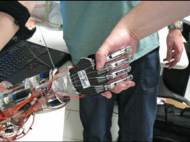Smart Hand – robotic hand gives amputees a sense of touch
 Developed by EU researchers, the Smart Hand is a complex prosthesis with four motors and forty sensors designed to provide realistic motion and sense to the user. Te sensors enabled it to become the first device of its kind to send signals back to the wearer, allowing them to feel what they touch. Phantom limb syndrome is the sensation amputees have that their missing body part is still there. The brain has remained open to receiving input from those nerves although they were cut off long ago. Likewise, impulses from the brain to control the missing limb still travel down the neurons towards the sight of amputation.
Developed by EU researchers, the Smart Hand is a complex prosthesis with four motors and forty sensors designed to provide realistic motion and sense to the user. Te sensors enabled it to become the first device of its kind to send signals back to the wearer, allowing them to feel what they touch. Phantom limb syndrome is the sensation amputees have that their missing body part is still there. The brain has remained open to receiving input from those nerves although they were cut off long ago. Likewise, impulses from the brain to control the missing limb still travel down the neurons towards the sight of amputation.
Scientists can use electronic sensors to pick up the control signals and relay them to a mechanical device. We’ve seen this technology used in the HAL exoskeleton from Cyberdyne, and in the i-Limb prostheses. Smart Hand is unique because it also takes advantage of those phantom limb pathways still being open. Doctors connect the sensors in the hand to the nerves in the stump of the arm, hence the patients can feel as well as in control of an artificial limb.
The goal of the Smart Hand project is to create a replacement limb that is almost identical to the lost one. In both objectives, the Smart Hand is far from ultimate success. Four motors, although providing an impressive range of motion, do not have the full degrees of freedom, nor the variation in applied strength that a human hand has. It is amazing that the forty sensors can communicate with the human brain at all, but they do not provide nearly as much sensation as the millions of nerves in your biological hand. Yet, as mentioned in the video, the current Smart Hand prototype represents more than ten years of dedicated work.
Robin af Ekenstam, the first amputee who tried their robotic hand, said it was just like using his real hand. He lost his hand after it was amputated in order to prevent a tumor spreading. He said: “It’s a feeling I have not had in a long time. When I grab something tightly I can feel it in the fingertips. It’s strange since I don’t have them any more! It’s amazing.”
He is able to use it in order to pick up objects, with a feedback manifested as a sense of touch on the fingertips of the prosthesis even at this stage of development. It is clear from his involvement in this project that this level of capability is well worth the time and effort involved. In other words, an imperfect Smart Hand is still a very desirable hand, and can perform remarkable tasks.
Beside limb replacement, it is thought the hand could also help eliminate ‘phantom pains’ that amputees and as a result improve their quality of life. Beyond that, if artificial limbs will one day match the human ones, there’s no reason they couldn’t be further improved. We would then see bionic limbs, or perhaps entirely bionic bodies, which exceed human limitations. Could these mechanical bodies be accepted as authentically human? The Olympic Committee already decided that some athletes with prostheses have an unfair advantage and are ineligible to compete. In the years to come we will see how society reacts when “good enough” becomes “good as new” and finally “better than ever”.









Smart Hand will be of much aid to amputees.
Dr.A.Jagadeesh Nellore(AP),India
e’ compatibile con una protesi mioelettrica otto bock